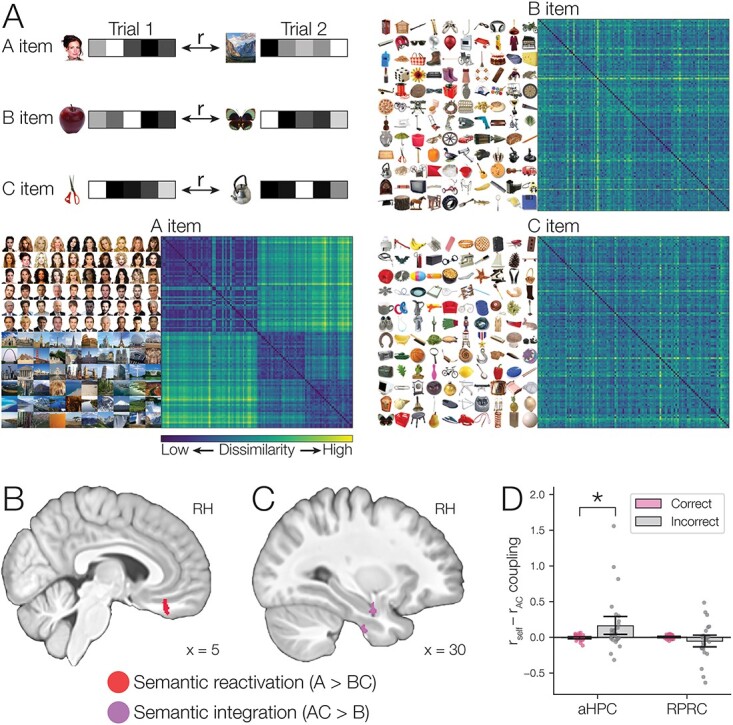Fig. 7.

(A) A model of semantic similarity was used to generate a vector representation of each item that reflects its semantic features. Each encoding trial had three semantic vectors, corresponding to different items (A, B, and C). The model allowed us to predict, for each participant, the similarity structure across trials that should be associated with semantic representations of different items. Matrices illustrate predicted dissimilarity of different encoding trials for one participant, with photographs indicating the relevant item on each trial. (B) During encoding of overlapping (BC) pairs, we tested for reactivation of semantic features related to the A item ( ) associated with each trial, contrasted with features related to the presented items (
) associated with each trial, contrasted with features related to the presented items ( ). We found that pmPFC showed evidence of reactivation of semantic features of the A item associated with each trial, which selectively predicted inference performance (
). We found that pmPFC showed evidence of reactivation of semantic features of the A item associated with each trial, which selectively predicted inference performance ( greater for correct subsequent inference than incorrect subsequent inference). (C) To test for areas involved in memory integration during overlapping encoding, we contrasted an integration model representing both the indirectly related A and C items (
greater for correct subsequent inference than incorrect subsequent inference). (C) To test for areas involved in memory integration during overlapping encoding, we contrasted an integration model representing both the indirectly related A and C items ( ) with a baseline model representing just the B item (
) with a baseline model representing just the B item ( ). Pattern similarity in aHPC and PRC showed evidence of greater memory integration on subsequently correct inference trials, relative to incorrect trials, suggesting that these regions are involved in integrating indirectly associated items. (D) Item activation in amPFC was correlated with integration in aHPC, only on encoding trials for which the subsequent inference judgment was incorrect. Trials with greater item suppression in amPFC were associated with a decrease in integration in aHPC. Error bars represent 95% bootstrap confidence intervals. Points indicate individual participants. *
). Pattern similarity in aHPC and PRC showed evidence of greater memory integration on subsequently correct inference trials, relative to incorrect trials, suggesting that these regions are involved in integrating indirectly associated items. (D) Item activation in amPFC was correlated with integration in aHPC, only on encoding trials for which the subsequent inference judgment was incorrect. Trials with greater item suppression in amPFC were associated with a decrease in integration in aHPC. Error bars represent 95% bootstrap confidence intervals. Points indicate individual participants. * . See also Figs. S2–S5.
. See also Figs. S2–S5.
